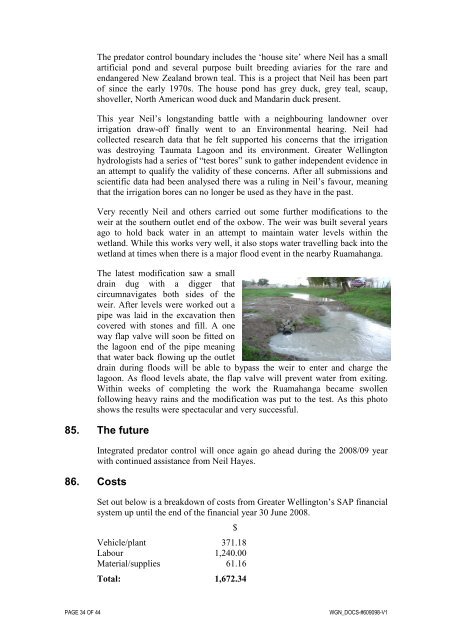Wairarapa Key Native Ecosystem Management Areas - Greater ...
Wairarapa Key Native Ecosystem Management Areas - Greater ...
Wairarapa Key Native Ecosystem Management Areas - Greater ...
You also want an ePaper? Increase the reach of your titles
YUMPU automatically turns print PDFs into web optimized ePapers that Google loves.
The predator control boundary includes the ‘house site’ where Neil has a small<br />
artificial pond and several purpose built breeding aviaries for the rare and<br />
endangered New Zealand brown teal. This is a project that Neil has been part<br />
of since the early 1970s. The house pond has grey duck, grey teal, scaup,<br />
shoveller, North American wood duck and Mandarin duck present.<br />
This year Neil’s longstanding battle with a neighbouring landowner over<br />
irrigation draw-off finally went to an Environmental hearing. Neil had<br />
collected research data that he felt supported his concerns that the irrigation<br />
was destroying Taumata Lagoon and its environment. <strong>Greater</strong> Wellington<br />
hydrologists had a series of “test bores” sunk to gather independent evidence in<br />
an attempt to qualify the validity of these concerns. After all submissions and<br />
scientific data had been analysed there was a ruling in Neil’s favour, meaning<br />
that the irrigation bores can no longer be used as they have in the past.<br />
Very recently Neil and others carried out some further modifications to the<br />
weir at the southern outlet end of the oxbow. The weir was built several years<br />
ago to hold back water in an attempt to maintain water levels within the<br />
wetland. While this works very well, it also stops water travelling back into the<br />
wetland at times when there is a major flood event in the nearby Ruamahanga.<br />
The latest modification saw a small<br />
drain dug with a digger that<br />
circumnavigates both sides of the<br />
weir. After levels were worked out a<br />
pipe was laid in the excavation then<br />
covered with stones and fill. A one<br />
way flap valve will soon be fitted on<br />
the lagoon end of the pipe meaning<br />
that water back flowing up the outlet<br />
drain during floods will be able to bypass the weir to enter and charge the<br />
lagoon. As flood levels abate, the flap valve will prevent water from exiting.<br />
Within weeks of completing the work the Ruamahanga became swollen<br />
following heavy rains and the modification was put to the test. As this photo<br />
shows the results were spectacular and very successful.<br />
85. The future<br />
Integrated predator control will once again go ahead during the 2008/09 year<br />
with continued assistance from Neil Hayes.<br />
86. Costs<br />
Set out below is a breakdown of costs from <strong>Greater</strong> Wellington’s SAP financial<br />
system up until the end of the financial year 30 June 2008.<br />
Vehicle/plant 371.18<br />
Labour 1,240.00<br />
Material/supplies 61.16<br />
Total: 1,672.34<br />
PAGE 34 OF 44 WGN_DOCS-#609098-V1<br />
$
















